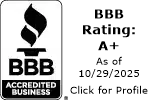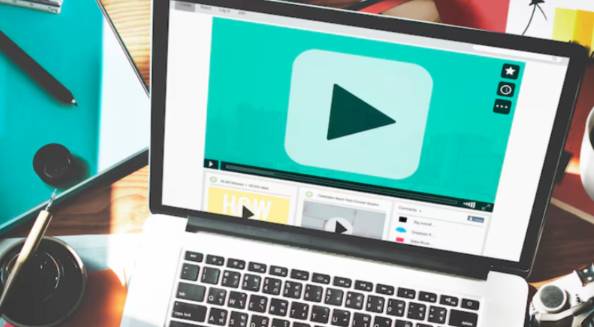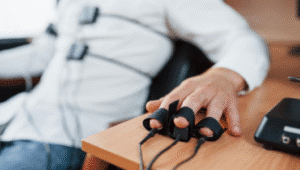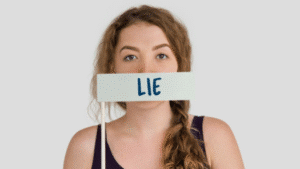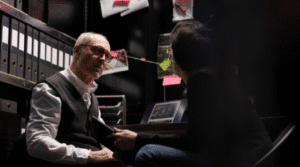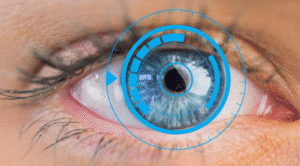Transparency has always been a topical issue in polygraphy. It’s one of the biggest ethical concerns that polygraph examiners mus t uphold, alongside other considerations like informed consent and data protection.
First, there are standards guiding question design formats. These rules foster transparency by prohibiting the examinee from asking potentially self-incriminating questions.
We also have guidelines on scoring and report compilation. For instance, all lie detector tests should culminate in a numerical score of deception. The percentages are based on the pattern of response to Relevant and Control questions.
However, not every polygraph examiner will play by these rules. To validate that a lie detector test was administered following the industry standards, a second layer of proof is necessary.
That’s where video documentation comes in.
What Is Video Documentation In Polygraphs?

Video documentation involves incorporating video recordings into a polygraph test. It’s a common practice in polygraphy designed to ensure that examiners follow standard practice, adding an extra layer of credibility to their findings.
Video evidence is critical during polygraphs since examiners typically don’t stare at the examinee during the tests. Instead, they focus on analyzing the biofeedback data captured by the polygraph machine on a computer screen.
By reviewing the video footage later, they can pick audiovisual nuances that are consistent with deception.
What Kind Of Data Does Video Documentation Capture?
Polygraph machines monitor physiological changes associated with lying, including blood pressure, pulse rate, respiration, and perspiration. Meanwhile, video recordings focus on the following information;
- Setting dynamics, such as sound and lighting conditions
- Examinee’s body language, including their posture and overall demeanor
- Statements made by the examinee, including admissions of guilt
- Tonal variations during the test
- Any intense moments during the exam, such as verbal exchanges
- Adherence to standard procedures

How Video Documentation Supports Transparency in Polygraphs
1. Validating Protocol
Polygraph examiners must uphold certain procedures to conduct legally defensible lie detector tests.
Standard procedures that video documentation may reveal include whether:
- The examiner used an approved question design formula
- Examiner maintained cordiality and professionalism throughout the test
- There were attempts to incriminate the examinee
2. Aiding Post-test Analysis
The post-test analysis is arguably the most challenging stage in the polygraph process. It’s here where reputations can be salvaged or irreparably damaged.
To interpret polygraph results, examiners must analyze the pattern of response to Control and Relevant questions. Deceptive characters typically respond strongly to Relevant than Control questions, while the converse is true for honest examinees.
A video camera can record verbal and nonverbal cues that an examinee could have missed during the test.
By combining these datasets with the physiological biofeedback recorded by a polygraph machine, examiners are able to draw more accurate inferences.
3. Quality Control Tool
Lie detector tests conducted by one examiner aren’t always final. For quality control, many polygraph associations require the findings to undergo third-party reviews.
Some independent reviewers may simply rely on the physiological data that informed an examiner’s scoring methodology to determine if the tests were properly administered.
But where the findings leave reasonable doubt, video footage can help validate the integrity of the process.

4. Checking the Test Duration and Its Potential Impact
Most lie detector tests last 1.5 – 2.5 hours. The exact duration depends on factors like the subject’s complexity, the number of questions asked, and the examinee’s overall disposition.
Polygraph duration may also vary depending on whether it’s a single-issue or multi-issue test.
Video documentation can prove how long a polygraph exam took and its potential impact on the examinee.
For instance, subjecting an examinee to over 2.5 hours of continuous, intense questioning can throw them off balance and possibly impact the test’s accuracy.
5. Preserving Admissions of Guilt
Polygraph findings may be legally inadmissible in many jurisdictions.
However, statements of guilt are typically allowed in judicial proceedings. That’s especially if it’s evident the examinee made such confessions wilfully and not under duress.
Video documentation provides the most reliable way to preserve admissions made during polygraph tests.
Note that an examiner will typically inform you when setting up a video camera. Therefore, any confession you make is construed as consciously and deliberately made.
6. Investigating Other Relevant Dynamics
Conducting a credible lie detector test doesn’t only require analyzing an examinee’s physiological reactions or verbal and non-verbal cues. Examiners must consider setting dynamics, too.
With video evidence, quality assessors can determine if a lie detector test was conducted in a stressful environment.
Loud sounds, bright lights, crowded venues, and tiny spaces are critical variables that can alter a polygraph’s credibility.
Now, anxiety doesn’t impact polygraph accuracy directly. However, taking a lie detector test in a stressful environment can cause distractions and prolong the process unnecessarily.

Capturing Lie Detector Nuances With Video Recording
Video documentation plays a critical role in lie detector tests. Using these recordings, examiners can pick visual and audio nuances they may have missed during the actual exam and draw more accurate inferences.
Video recordings also validate that a polygraph test was followed due procedure. It reveals critical details that could be used to challenge the test, such as whether wilful consent was given, and whether the polygraph questions were properly framed.
However, remember that incorporating video documentation into polygraphs doesn’t discount the significance of working with an experienced polygrapher.

